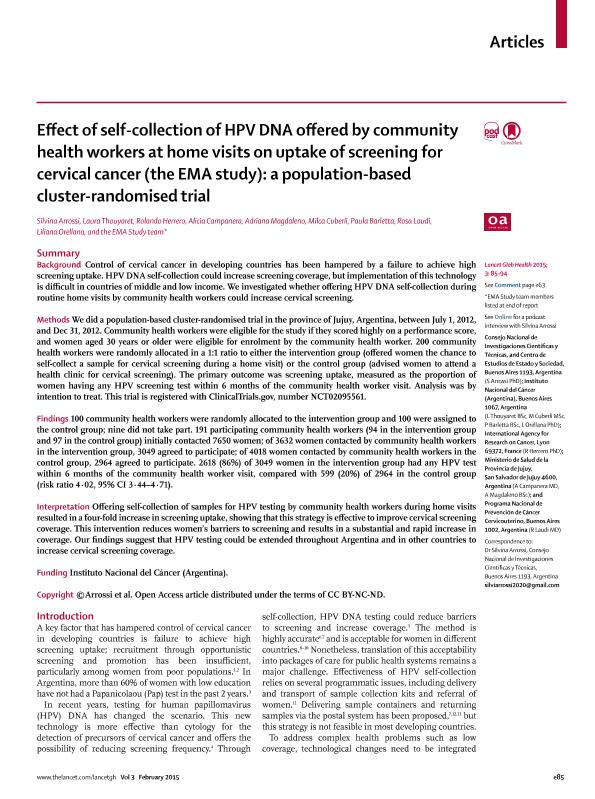Artículo
Effect of self-collection of HPV DNA offered by community health workers at home visits on uptake of screening for cervical cancer (the EMA study): A population-based cluster-randomised trial
Arrossi, Silvina ; Thouyaret, Laura; Herrero, Rolando; Campanera, Alicia; Magdaleno, Adriana; Cuberli Alonso, Milca Beatriz
; Thouyaret, Laura; Herrero, Rolando; Campanera, Alicia; Magdaleno, Adriana; Cuberli Alonso, Milca Beatriz ; Barletta, Paula; Laudi, Rosa; Orellana, Liliana
; Barletta, Paula; Laudi, Rosa; Orellana, Liliana
 ; Thouyaret, Laura; Herrero, Rolando; Campanera, Alicia; Magdaleno, Adriana; Cuberli Alonso, Milca Beatriz
; Thouyaret, Laura; Herrero, Rolando; Campanera, Alicia; Magdaleno, Adriana; Cuberli Alonso, Milca Beatriz ; Barletta, Paula; Laudi, Rosa; Orellana, Liliana
; Barletta, Paula; Laudi, Rosa; Orellana, Liliana
Fecha de publicación:
02/2015
Editorial:
Elsevier
Revista:
The Lancet Global Health
ISSN:
2214-109X
Idioma:
Inglés
Tipo de recurso:
Artículo publicado
Clasificación temática:
Resumen
Background: Control of cervical cancer in developing countries has been hampered by a failure to achieve high screening uptake. HPV DNA self-collection could increase screening coverage, but implementation of this technology is difficult in countries of middle and low income. We investigated whether offering HPV DNA self-collection during routine home visits by community health workers could increase cervical screening. Methods: We did a population-based cluster-randomised trial in the province of Jujuy, Argentina, between July 1, 2012, and Dec 31, 2012. Community health workers were eligible for the study if they scored highly on a performance score, and women aged 30 years or older were eligible for enrolment by the community health worker. 200 community health workers were randomly allocated in a 1:1 ratio to either the intervention group (offered women the chance to self-collect a sample for cervical screening during a home visit) or the control group (advised women to attend a health clinic for cervical screening). The primary outcome was screening uptake, measured as the proportion of women having any HPV screening test within 6 months of the community health worker visit. Analysis was by intention to treat. This trial is registered with ClinicalTrials.gov, number NCT02095561. Findings: 100 community health workers were randomly allocated to the intervention group and 100 were assigned to the control group; nine did not take part. 191 participating community health workers (94 in the intervention group and 97 in the control group) initially contacted 7650 women; of 3632 women contacted by community health workers in the intervention group, 3049 agreed to participate; of 4018 women contacted by community health workers in the control group, 2964 agreed to participate. 2618 (86%) of 3049 women in the intervention group had any HPV test within 6 months of the community health worker visit, compared with 599 (20%) of 2964 in the control group (risk ratio 4·02, 95% CI 3·44-4·71). Interpretation: Offering self-collection of samples for HPV testing by community health workers during home visits resulted in a four-fold increase in screening uptake, showing that this strategy is effective to improve cervical screening coverage. This intervention reduces women's barriers to screening and results in a substantial and rapid increase in coverage. Our findings suggest that HPV testing could be extended throughout Argentina and in other countries to increase cervical screening coverage. Funding: Instituto Nacional del Cáncer (Argentina).
Palabras clave:
Argentina
,
Hpv- Test Self-Collection
,
Effectiveness
,
Screening
Archivos asociados
Licencia
Identificadores
Colecciones
Articulos(SEDE CENTRAL)
Articulos de SEDE CENTRAL
Articulos de SEDE CENTRAL
Citación
Arrossi, Silvina; Thouyaret, Laura; Herrero, Rolando; Campanera, Alicia; Magdaleno, Adriana; et al.; Effect of self-collection of HPV DNA offered by community health workers at home visits on uptake of screening for cervical cancer (the EMA study): A population-based cluster-randomised trial; Elsevier; The Lancet Global Health; 3; 2; 2-2015; e85-e94
Compartir
Altmétricas



